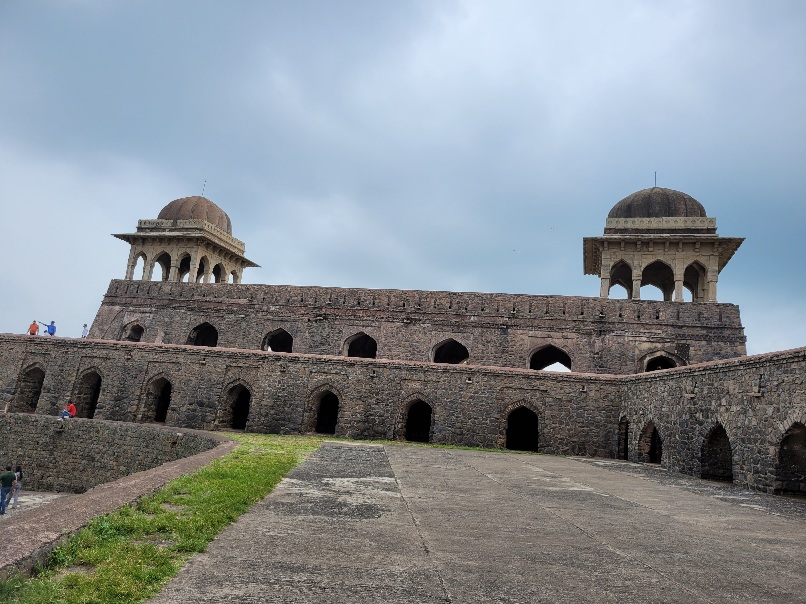A tour to the historic city of Mandu is incomplete without a visit to the Rani Roopmati Mahal which stands as a testament to the eternal love saga that still haunts the air of Mandu. Rani Roopmati Mahal, an ode to love, is one of the many monuments that dot the landscape of Mandu, the historical city of Madhya Pradesh. The sandstone structure sits atop a hillock about 365m high overlooking the Nimar Valley with the Baz Bahadur Palace to the South.
The palace bears witness to the legendary tragic love story of Baz Bahadur, the last Sultan of Mandu and renowned poet-singer, Rani Roopmati, his queen in the mid 16th century.. Roopmati Mahal echoes a love story from the hardest of hearts, regardless of the era.The love story transcends religion and worldly ties, and it is a story of love and sacrifice that will live on forever.The palace is included in the Rewa Kund group of monuments and is a must-see for anyone visiting Mandu.
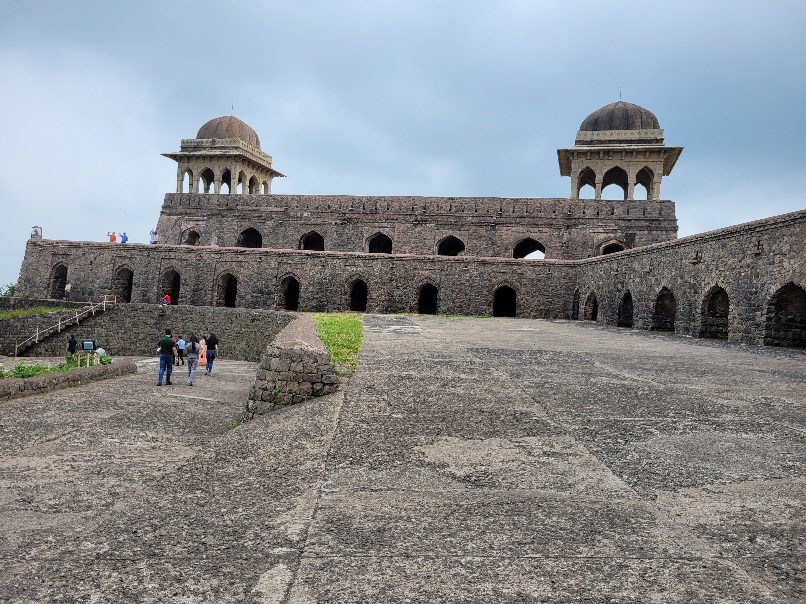
Post Contents
History and The Folklore
Until 1305, Mandu was known as ‘Mandap Durga,’ with a small fort and a few temples. The last ruler, however, was no match for the army dispatched by Allaudin Khilji under the command of his trusted general. The Hindu kingdom fell to the Delhi Sultanate and was taken over by Muslim governors. The governor appointed by the Tughlaq Dynasty, on the other hand, declared independence from Delhi and assumed royal titles.
Mandu was fortified and most of the buildings were constructed during the reign of these self-appointed rulers and their descendants. Baz Bahadur was the last ruler of Mandu before it was seized by the Mughals.
But,it is the love story of Sultan Baz Bahadur and Rani Roopmati which has caught the imagination of the tourists and locals that still reverberates in the hearts of the people. With her sonorous voice, Roopamati, a shepherdess, drew the attention of Sultan Baz Bahadur. Soon after, they fell in love and married.
The Roopmati pavilions are credited with facilitating Roopamati’s desire to worship River Narmada first thing in the morning. Rani Roopmati’s regular itinerary included a visit to the pavilion to catch a glimpse of the River Narmada, which appears as a gleaming silver strip from the pavilion’s terrace.
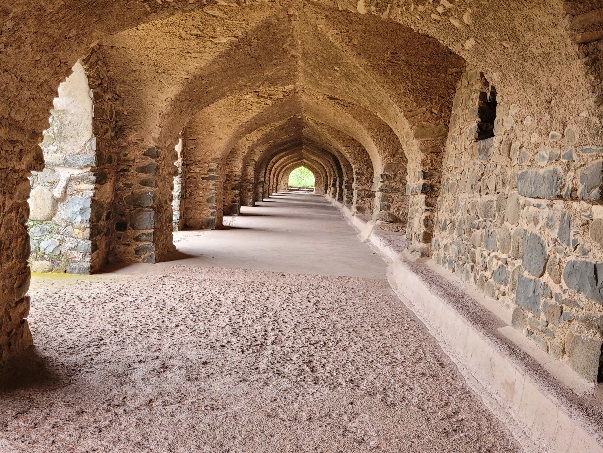
Related Aricle: Walking Through Time: A Tour of Jahaz Mahal in Mandu
Baz bahadur and Rupmati had a wonderful life filled with music and poetry. However, Baz Bahadur was unable to maintain a strong defensive force. After being defeated by a powerful Mughal army, Baz Bahadur fled the battlefield, seeking refuge in nearby small kingdoms. To avoid having her honour sullied by Adham Khan, the general of the Mughal army, Queen Roopmati killed herself rather than allowing herself to be captured.
Thus ended the beautiful love story of two compassionate human beings who, despite being of different religions and social classes, defied all social norms by falling in love and marrying.
Mandu has a tumultuous history, but the tragic love story of Sultan Baz Bahadur and his consort Rani Roopmati lives on in folklore and songs of Malwa region.
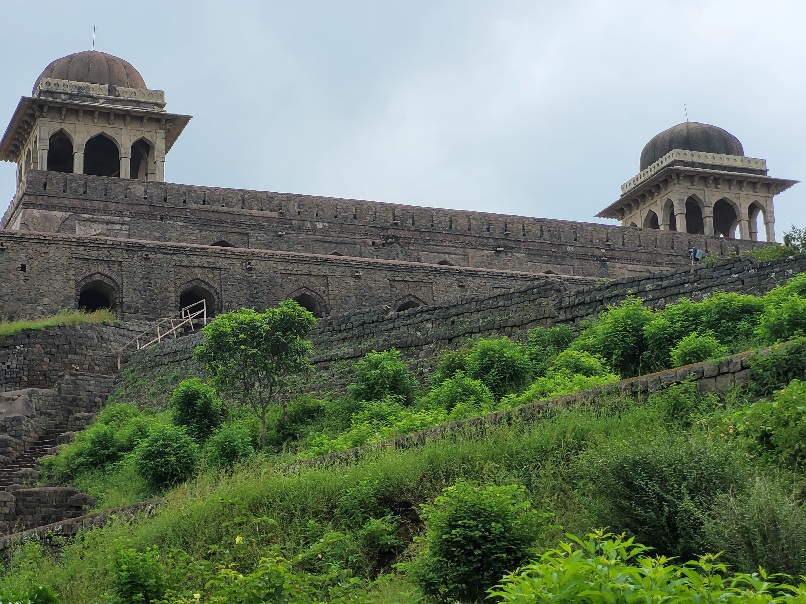
The Rani Roopmati Mahal or Pavilion
Originally designed as an army observation post, the structure evolved into a symbol of Baz Bahadur and Rani Roopmati’s undying love. Roopmati’s Pavilion, located to the south of Baz Bahadur’s Palace, was originally a low and large hall with two rooms on each side and a thick sloping base. Later, the western side of the building was extended along the plinth, with the most interesting additions being square pavilions housing hemispherical domes.
The corridors in the basement of Roopmati’s Pavilion have a number of arched openings running the length of them. The western ledge houses a large reservoir where rainwater was collected during the monsoon via a channel running from the structure’s roof to the tank below.
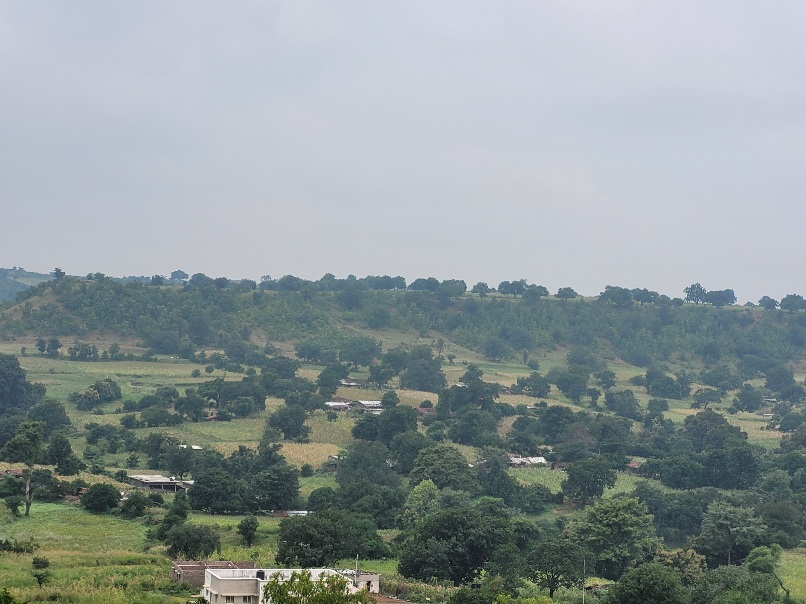
Do Read: Your Ultimate Guide to visit Mahakaleshwar Temple in Ujjain
Also the breathtaking view of river Narmada flowing 305 meters below is a sight to behold.
What makes Rani Roopmati Mahal special is its geographic location.From the pavilion you can mark the boundary between Nimar and the Malwa plateau. The palace’s strategic location helped in monitoring any military activity on the lower grounds on either side. This is why the Pratihar and Parmar rulers made this palace their military hub. On the ground floor of the palace, there was a big building built for the accommodation of soldiers.
The Rani Roopmati Pavilion is maintained by the Archaeological Survey of India and is a magnificent expression of Afghan architecture in sandstone.It is also a great spot to watch the sunset over the Narmada River.
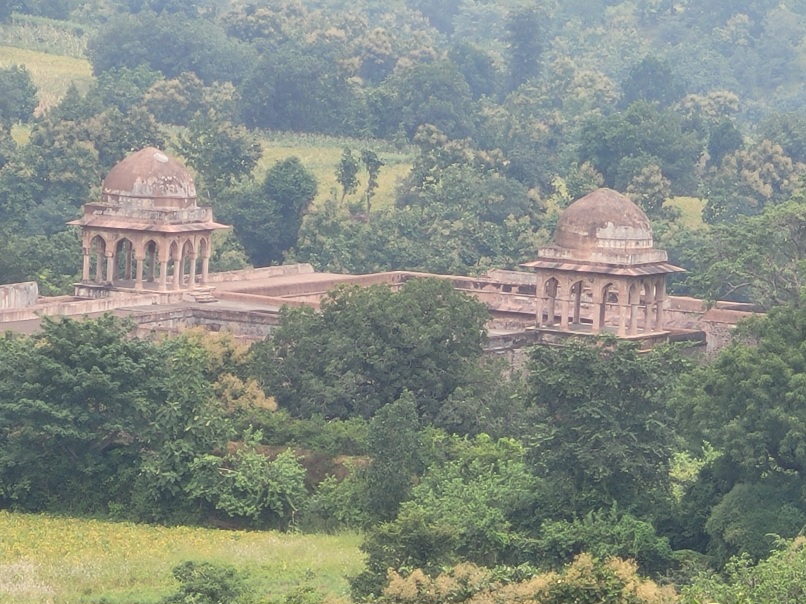
Monuments related to Rani Roopmati Mahal
Among many others, there are at least two other monuments which are closely associated with Rani Roopmati and Sultan Baz Bahadur which are must-visits in Mandu. The two monuments namely Baz Bahadur Palace and Rewa Kund are not very far from the Rani Roopmati Mahal and are witness to the love saga of the Sultan and the queen. The two monuments come under the Rewa Kund group monuments of Mandu and must be visited to completely understand the folklore and history that has been long echoing in the stones of Mandu.
Baz Bahadur Palace
The Baz Bahadur Palace is set among picturesque greenery on a hill slope to the east of Rewa Kund. According to the Persian inscription on the entrance arch, it was built in 1508 by Nasir-ud-Din, Sultan of Malwa. In fact, Nasir-ud-Din Shah Khilji is credited with designing this aesthetically beautiful structure, which underwent repairs and renovations during the reign of Baz Bahadur. The King grew fond of this palace as a result of his eternal romance with the accomplished singer Roopmati, who used to visit the nearby Rewa Kund.
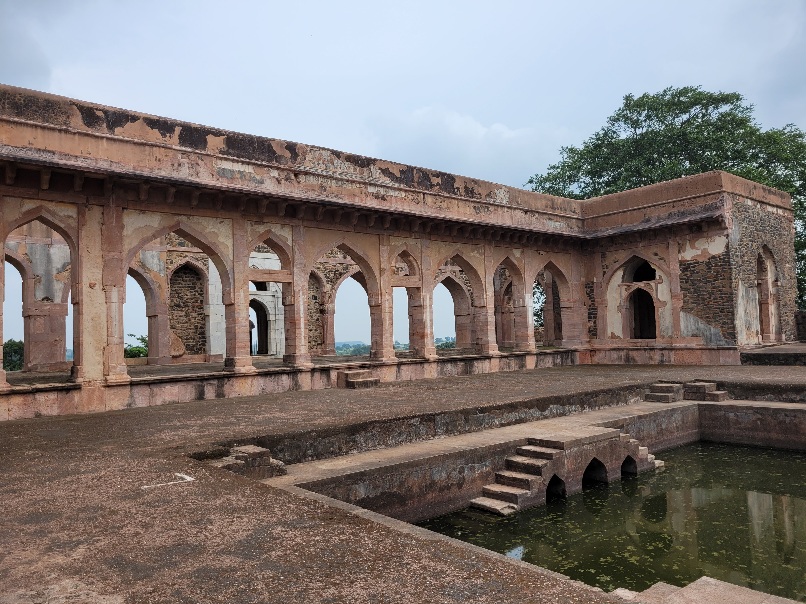
Also Read: Qutub Minar: The Towering Landmark of Delhi
The main gateway to the palace is approached by 40 broad steps that is an amalgamation of Rajput and Mughal architectural styles. At the entrance to this the double storeyed palace, tall, sleek arches greet visitors. An aqueduct ran on top of the arches in its heyday, transporting water from Rewa Kund to the pool in the palace courtyard. The palace also has a large courtyard with halls and rooms on all four sides and a beautiful cistern in the centre. Between 1555 and 1561, Baz Bahadur held court in these halls.
A couple of chhatris, or elevated domed pavilions, adorn the palace terrace. One of the big rooms, which still has amazing natural acoustics today, served as the palace’s music and dance hall. The palace is a prime example of the art and architecture of that era.
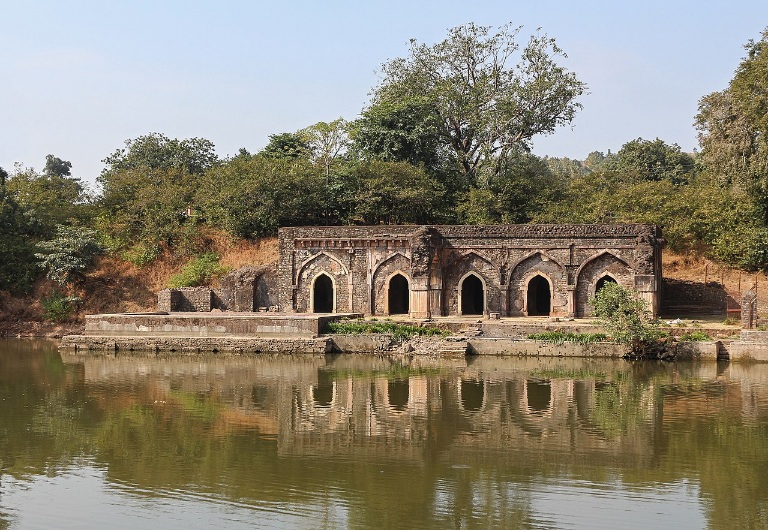
Rewa Kund of Mandu
Rewa Kund is another monument that is dedicated to Baz Bahadur and Roopmati’s legendary love story. This lake, which is part of the Rewa Kund Group of Monuments, was built by Baz Bahadur to ensure water supply to Roopmati’s pavilion. According to legend, Roopmati worshiped the Narmada River and used to watch it from the top of her Pavilion. Baz Bahadur built the Rewa Kund, which drew its water from the Narmada River. As a result, Roopmati regularly came to worship at this Kund.
This artificial lake is about 230 feet long in the North-South direction and 170 feet long in the East-West direction. The pavilion on the northwest side of the lake has been expanded over time, displaying varying styles of pillars and arches, providing a resting area for pilgrims and pleasure seekers alike. A water lift at the lake’s northern end supplies water to Baz Bahadur’s palace. Bathing is no longer permitted in the Kund, but the water is clean.
Rani Roopmati in popular culture
While the love story of Rani Roopmati and Sultan Baz Bahadur echoes in the history of Mandu, the love saga also finds many takers in popular culture including literature and movies. The story of Rani Roopmati has been adapted into several films in India, including Rani Rupmati (1931) by Bhalji Pendharkar in which versatile actress Sulochana Chaterjee played the role of the queen.
Rani Rupmati (1957) directed by S.N. Tripathi, starring Nirupa Roy in the title role is another popular film that portrayed the love of the sultan and the queen. Actor Kuldip Kaur played the queen in the 1952 film Baiju Bawra, in which she was portrayed as a dacoit.
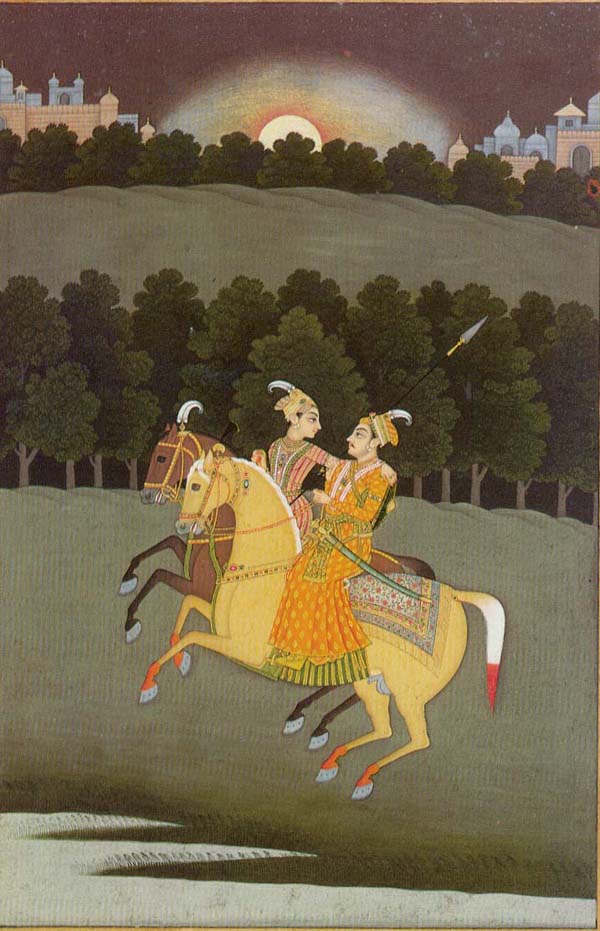
Do Read: 12 Amazing Bhopal tourist places that you must not miss (2022)
Travel Tips
- The nearest airport to Mandu is at Indore, which is around 110 km away from the city. One can avail private taxis or book a cab to reach their destination in Mandu from the Indore airport. Indore Airport is well connected to all the major cities of India including Mumbai and Delhi.Indore Railway Station is the nearest railway station to reach Mandu. Tourists can get bus service or private taxis from the station to reach their hotel in Mandu.Mandu is easily accessible through road and can be reached easily from nearby cities like Indore, Jabalpur and Gwalior. There are frequent bus services from these cities to reach Mandu; also one can book a private taxi to come to this town on their own.
- Mandu can be visited at any time of the year, however, if you are very keen on enjoying the exquisite weather of the city, do visit it during the monsoon season. The emerald green landscape of Mandu looks prettier during rain. Winter too is not bad if you really want to experience the cool breeze of this historic town in the months between October and January.
- The local markets of Mandu offer various art forms to tourists in the form of handicrafts, fabric, decorative items, antiques, etc. There are several Craft Development Centres in Mandu that sells beautiful sarees in Chanderi, block print, silk chiffon hand woven sarees, Maheshwari, Gudi-Mudi, Khadi, Dabu prints, Tussar Silk Weaving, Bagh Prints, Tribal Saree collection, woolen carpet, cotton panja dari, leather crafts, etc.
- Mandu offers several budget as well as luxury options to stay comfortably in the pleasant surroundings of the town. There are a lot of options that are pocket-friendly like Dharamshalas (Guest houses) and low budget hotels. Most of the star hotels in the area are located near popular destinations like Jahaz Mahal and Dai Ka Mahal.
- There are many vegetarian restaurants in Mandu that serve delicious Mughal-style cuisine. Some of the restaurants even serve interestingly prepared South Indian, Chinese, and Malwa cuisines. You must try Mandu Ki Imli, a fruit of the Boabab tree, which is used to make kebabs, bhutte ki kees, mawa-bati, khopra pak, and malpua.

